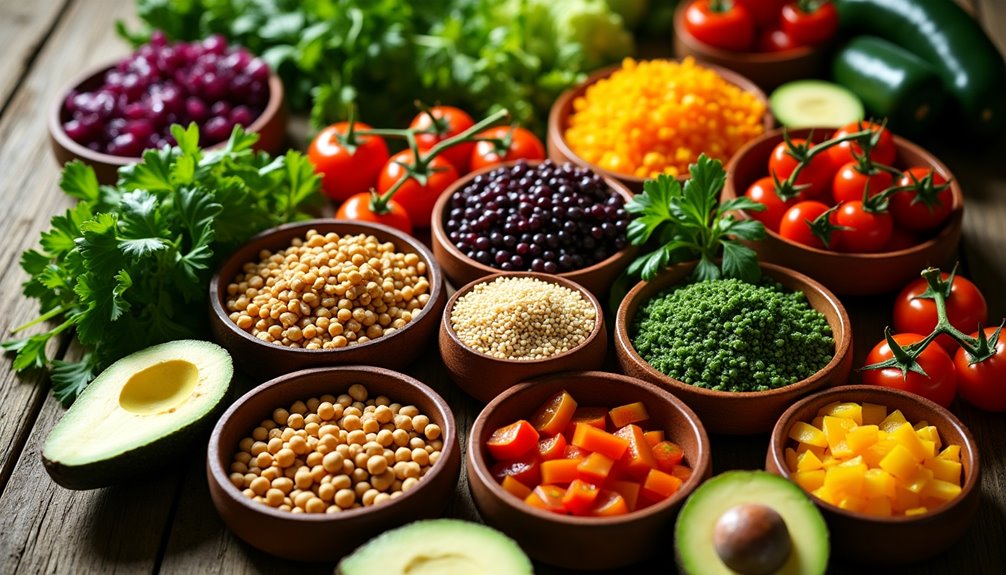The Blue Zone Diet emphasizes consuming whole, plant-based foods that promote longevity and good health. Inspired by regions like Okinawa and Sardinia, this diet focuses on fruits, vegetables, legumes, and whole grains, which provide essential nutrients and protein. It helps manage weight and reduces the risk of chronic diseases, including heart disease and diabetes. Alongside healthy eating, active lifestyles and strong social connections are vital for overall well-being. By planning meals and engaging with supportive communities, you can stay committed to this diet. There's much more to explore about its benefits and recipes that can enhance your journey.
Key Takeaways
- The Blue Zone Diet emphasizes whole, plant-based foods such as legumes, fruits, and vegetables for optimal health and longevity.
- It promotes nutritional balance through meal planning, portion control, and mindful eating practices.
- Regular physical activity and natural movement are essential lifestyle factors contributing to longevity in Blue Zone communities.
- Building social connections and community support enhances adherence to the Blue Zone Diet and fosters emotional well-being.
- Experimenting with diverse foods and recipes keeps meals exciting and encourages a sustainable dietary transition.
Overview of Blue Zones

Blue Zones are areas around the world where people consistently live longer, healthier lives, often reaching age 100 at a remarkable rate. These regions, identified by researchers, include locations like Okinawa in Japan, Sardinia in Italy, and Loma Linda in California. What's fascinating is how cultural influences contribute to the longevity secrets found in these areas.
In Blue Zones, lifestyle choices play a significant role in promoting health and longevity. For instance, social connections are strong, with communities fostering a sense of belonging and support. People in these regions prioritize family, friendships, and shared activities, which not only enhance emotional well-being but also promote a healthier lifestyle. You'll find that these relationships often lead to lower stress levels, a key factor in maintaining health over the years.
Moreover, traditional diets in Blue Zones often emphasize plant-based foods, whole grains, and legumes. This dietary pattern aligns with the cultural practices passed down through generations, reinforcing the importance of food as a communal experience. In fact, adopting a plant-based diet can offer significant health benefits such as reducing the risk of chronic diseases.
Meals are typically enjoyed with family and friends, fostering strong bonds and cultural ties.
While the specific longevity secrets may vary from one Blue Zone to another, the common thread is the harmonious blend of cultural influences, lifestyle choices, and dietary habits. By exploring these regions, you can gain valuable insights into how to enhance your own life, drawing inspiration from their practices to create a healthier, more fulfilling existence.
Key Principles of the Diet

A key aspect of the Blue Zone Diet revolves around its emphasis on whole, minimally processed plant-based foods. This approach not only promotes a healthier lifestyle but also fosters a sense of community and belonging among those who adopt it. By focusing on nutritional balance, you can guarantee that your meals are both satisfying and beneficial for your overall well-being. Additionally, incorporating whole food sources of protein into your meals can enhance energy levels and support muscle building.
To effectively implement the Blue Zone principles, meal planning becomes essential. Here's a quick reference table to guide you:
| Principle | Description |
|---|---|
| Whole Foods | Prioritize fresh fruits, vegetables, and grains. |
| Plant-Based Proteins | Incorporate legumes, nuts, and seeds for protein. |
| Healthy Fats | Use sources like olive oil and avocados. |
| Portion Control | Serve smaller portions to avoid overeating. |
| Mindful Eating | Eat slowly and appreciate your food.
Major Food Groups

Understanding the major food groups in the Blue Zone Diet is crucial for creating balanced meals that align with its principles. This diet emphasizes a variety of plant-based foods, which not only promote nutritional balance but also contribute to overall well-being. You'll want to incorporate whole grains, legumes, fruits, and vegetables as your primary food sources. These items are rich in vitamins, minerals, and fiber, making them essential components of your daily meals.
In meal planning, aim for a colorful plate filled with diverse food sources. Think about including beans, lentils, and nuts, which provide protein while keeping saturated fats low.
Whole grains, like quinoa and brown rice, can serve as satisfying bases for your meals. Fruits and vegetables should take center stage, offering crucial nutrients and antioxidants to support your health.
Portion control is another key aspect of the Blue Zone Diet. It encourages you to listen to your body's hunger cues and eat until satisfied rather than stuffed. By focusing on smaller portions of nutrient-dense foods, you can maintain a healthy weight and enjoy a variety of flavors. Additionally, adopting a diet that enhances metabolism can further assist in achieving and maintaining your health goals.
Lifestyle Factors

Lifestyle factors play an important role in the success of the Blue Zone Diet. While the diet emphasizes plant-based foods, it's essential to recognize how your everyday choices impact overall health and longevity. Two key lifestyle factors that stand out are exercise habits and social connections.
In Blue Zones, regular physical activity isn't just a scheduled workout; it's woven into daily life. People engage in natural movement through gardening, walking, or manual labor. You might consider incorporating more movement into your routine, whether it's taking the stairs or going for a brisk walk. This consistent, low-intensity exercise fosters better cardiovascular health and maintains mobility, which are necessary for aging gracefully.
Equally important are social connections. In Blue Zones, people prioritize relationships and community engagement. They spend time with family and friends, often gathering for meals or community events. Research shows that strong social connections can lead to a longer and healthier life.
You can enhance your well-being by nurturing these social ties. Engaging in meaningful conversations and shared activities not only enriches your life but also provides emotional support, which is essential for mental health.
Health Benefits

While following the Blue Zone Diet, you can anticipate a variety of health benefits that contribute to overall well-being and longevity. This diet, based on the eating habits of the world's longest-lived populations, offers longevity secrets that can enhance your quality of life. The emphasis on plant-based foods, whole grains, and healthy fats helps reduce the risk of chronic diseases, promoting disease prevention.
The Blue Zone Diet promotes a balanced intake of nutrients that can result in significant health improvements. Here's a brief overview of some key benefits:
| Health Benefit | Description | Impact on Lifestyle |
|---|---|---|
| Improved Heart Health | Rich in omega-3 fatty acids and antioxidants | Lowers risk of heart disease |
| Enhanced Mental Clarity | Nutrient-dense foods nourish brain function | Supports cognitive health |
| Weight Management | Emphasizes whole foods and portion control | Aids in maintaining a healthy weight |
By prioritizing fresh fruits, vegetables, legumes, and nuts, you're not just nourishing your body; you're also establishing a framework for a healthier future. Research shows that those who embrace these dietary patterns experience lower rates of cancer, diabetes, and cardiovascular diseases. Additionally, following a diet that minimizes oxidized cholesterol can further support cardiovascular health and prevent plaque buildup in arteries.
Incorporating the Blue Zone Diet into your lifestyle can lead to a vibrant and fulfilling life as you discover the secrets to longevity and prioritize disease prevention. Embrace these changes, and witness the positive shifts in your health and well-being.
Tips for Implementation

To successfully adopt the Blue Zone Diet, you'll want to focus on practical steps that integrate these principles into your daily routine. Start with meal planning. Devote a few hours each week to outline your meals, ensuring you incorporate whole foods, plant-based ingredients, and healthy fats. This not only simplifies your grocery shopping but also helps you resist the allure of processed foods. By preparing meals in advance, you make it easier to stick to the diet, even on busy days.
Next, prioritize your social support. Surrounding yourself with like-minded individuals can greatly enhance your commitment to the Blue Zone Diet. Engage family and friends in your journey; cook together, share recipes, and discuss your progress. This creates a sense of belonging and reinforces healthy habits.
Consider joining local or online communities focused on plant-based eating. Sharing experiences and challenges can provide motivation and accountability.
Additionally, don't forget to experiment with new foods and recipes. Variety keeps your meals exciting and satisfying, making it less likely you'll stray from your goals. Remember, the Blue Zone Diet isn't just about food; it's about cultivating a lifestyle that promotes health and well-being. To further support your journey, you might explore the benefits of a custom keto diet plan that can help you personalize your meal choices and track your progress effectively.
Stay patient and flexible as you shift to this diet. It's a journey, and small, consistent changes can lead to lasting results. By integrating meal planning and leveraging social support, you'll find it easier to embrace the Blue Zone Diet and its numerous benefits.
Recipes to Try

Embracing the Blue Zone Diet opens the door to a world of delicious and nutritious meals that can enhance your health and well-being. This diet emphasizes whole, plant-based foods rich in antioxidants, fiber, and healthy fats. To get you started, here are some recipes that highlight vibrant flavor combinations while keeping meal prep simple.
For breakfast, try a Mediterranean quinoa bowl. Cook quinoa and top it with chopped tomatoes, cucumbers, olives, and a drizzle of olive oil. Add a sprinkle of feta cheese for a satisfying finish. This dish isn't only nutritious but also a breeze to prepare ahead of time.
For lunch, whip up a chickpea salad with red onion, bell peppers, and a squeeze of lemon juice. This dish packs a protein punch and is perfect for meal prep; you can make a large batch and enjoy it throughout the week.
For dinner, consider a hearty vegetable stew. Combine seasonal vegetables like zucchini, carrots, and kale in a pot with vegetable broth and your choice of herbs. This recipe allows for endless flavor combinations and can be customized to suit your taste. Embracing natural calorie cycles can further enhance the benefits of these wholesome meals.
Frequently Asked Questions
Are There Any Specific Foods to Avoid on the Blue Zone Diet?
When considering a healthy lifestyle, it's important to avoid certain foods. You should steer clear of processed foods, as they often contain unhealthy additives.
High sugar intake is another factor to watch out for, contributing to various health issues.
Additionally, limiting alcohol consumption and red meat is wise, as they can negatively impact overall well-being.
How Does the Blue Zone Diet Compare to Other Popular Diets?
When it comes to diets, think of them as unique paths through a lush forest. Each has its own twists and turns.
While many focus on weight loss strategies and quick fixes, you'll find the Blue Zone approach emphasizes nutritional benefits and sustainable living. It champions whole foods and mindful eating, fostering a sense of belonging and community.
Unlike others, it's less about restriction and more about embracing a vibrant, healthy lifestyle that nurtures you.
Can Children Follow the Blue Zone Diet?
Absolutely, kids can follow a diet that emphasizes whole, plant-based foods. You can easily find kid-friendly recipes that incorporate fruits, vegetables, whole grains, and legumes, making it fun and nutritious. Just make sure you're meeting their nutritional guidelines by providing a variety of foods to cover all essential nutrients.
Involving your kids in meal prep can also help them feel included and excited about healthy eating habits.
Is the Blue Zone Diet Suitable for Vegetarians or Vegans?
Imagine a garden thriving with vibrant vegetables and legumes, each one a key player in your nutritional balance.
If you're a vegetarian or vegan, you'll find that the Blue Zone diet can suit you well. It emphasizes plant-based foods, offering plenty of protein sources like beans, lentils, and nuts. By incorporating these into your meals, you can enjoy a fulfilling diet that promotes health and longevity while aligning with your values.
How Does the Blue Zone Diet Impact Mental Health?
The foods you eat can greatly impact your mental health. By focusing on whole, plant-based foods, you enhance your gut-brain connection, which is essential for mood regulation. Incorporating mindfulness practices and stress management techniques helps you cultivate a positive mindset.
A balanced diet rich in nutrients supports neurotransmitter function, promoting emotional well-being. Ultimately, what you choose to consume can lead to improved mental clarity and resilience against stressors in everyday life.
Conclusion
By adopting the Blue Zone diet, you're not just changing what's on your plate—you're embracing a lifestyle that could enhance your longevity and well-being. Imagine waking up each day with renewed energy and essentiality, ready to face life's challenges. But will you take the first step toward this transformative journey? The secrets of the world's longest-living people await you, and the choice to access these benefits is yours. Will you seize the opportunity for a healthier, longer life?



